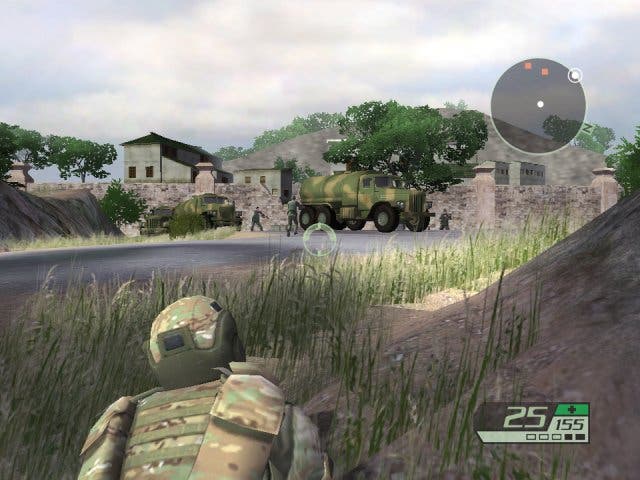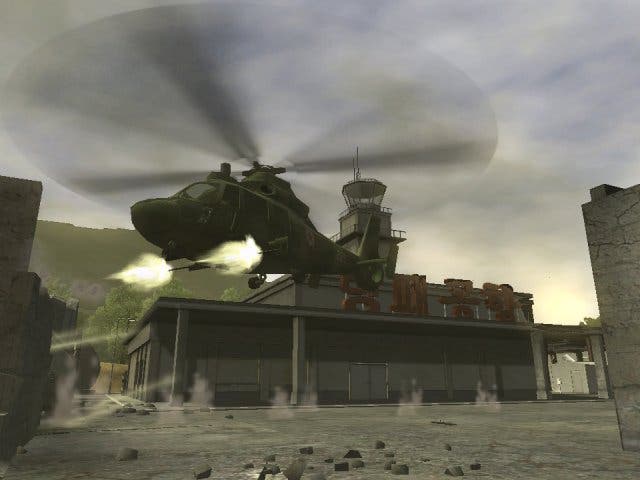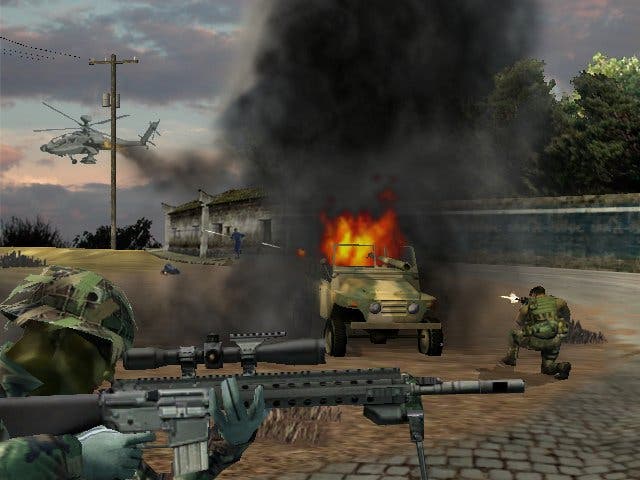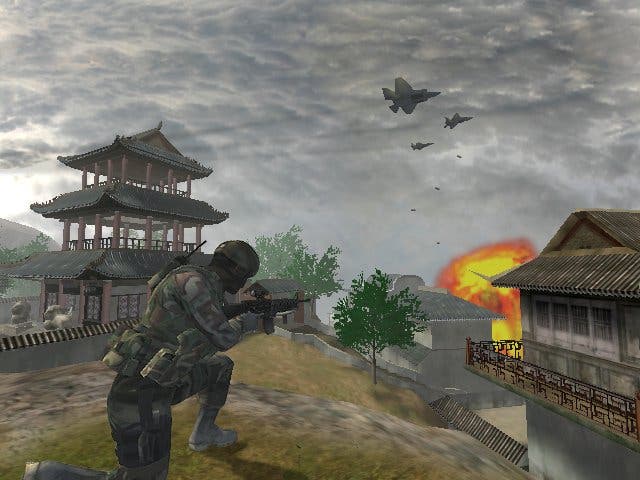Tom Clancy's Ghost Recon 2
We recon you might like this one.

For reasons not entirely clear, the original Ghost Recon totally passed this reviewer by, despite my having played all the other Tom Clancy games that Ubisoft and Red Storm have been churning out over the last six or so years. Maybe it was the dreadfully uninspiring, muddy, dated visuals that failed to grab the attention the way that Splinter Cell did so effortlessly. Having booted it up it just... didn't grab me. Having played the sequel thoroughly and enjoyed it immensely, yours truly is wondering how he managed to be so dismissive of a game that so obviously pushes so many of the right gaming buttons. These things happen.
The first thing Red Storm has been at pains to address was to overhaul visuals that, by its own admission, were well behind the standard you'd expect from any current gen game. Having struggled to get to grips with the memory restraints of console technology (having previously been ingrained with the lack of optimisation skills that many PC developers come burdened with), the steep learning curve has paid off. The most sensible changed has been to ditch its proprietary tech and usher in the ever-flexible Unreal engine and produce a game that does justice to what the team was gunning for the first time around. If you too have previously chosen to ignore the original and its budget-priced standalone mission pack Jungle Storm (an honest tactic that Ubisoft and Red Storm should be warmly applauded for) then it's simple to think of the Ghost Recon series as Rainbow Six's outdoor-based partner in squad-based elite military butt-kicking.
In Ghost Recon's case you're part of a four-man team of 'Ghosts', a squad of crack military personnel tasked with defusing flashpoint situations; not the kind of frantic terrorist situations of R6, but more to win wars before they even start. Set in near future North Korea - in this case 2011 - the overall campaign is to stop a power hungry general from igniting a regional war. And this is where you come in, playing the entire campaign as Scott Mitchell, a veteran of campaigns in Russia and Cuba with "a reputation for bringing his soldiers home alive". That is, until we started controlling his actions, at least...
I aint 'fraid of no Ghost

The first thing anyone familiar with Rainbow Six will note is how much in common the two games have in just about every area imaginable. Essentially, if you've played and enjoyed a R6 game the interface and 'feel' is almost identical, so you should get on just fine here (although has implemented a third person 'over the shoulder' viewpoint by default, as well as a gunless first person viewpoint that we soon ditched). Again, you have direct control over the squad leader and have overall tactical responsibility over the actions of three other Ghosts dictating basics such as where to move to, whether to follow or hold position, suppress enemy fire as well as flank left or right. It's as straightforward and intuitive a control set up as has been devised for a squad-based game on a console, and in the exact same fashion as R6 packs a whole range of fundamentals onto a humble joypad without compromising on the number of commands at all. But should the interface seem a bit complicated there's always voice recognition support, meaning you can bark orders into the Voice Communicator and upset your housemates and neighbours into the bargain.
Again, as with R6, the success of each mission depends on keeping the squad leader alive, so although you can solider on when members of your team cop a bullet, should Mitchell go down it's time to load in the last save game. Talking of which, the limited save mechanic that served R6 III and its expansion Black Arrow has been abandoned in favour of a much saner 'save anywhere' system - a decision that makes it much easier to scout out levels first without having to constantly backtrack five minutes or more first. It does, however, make the game much easier as a result, with the progress from every mini firefight inevitably being saved to avoid getting caught out.
But unlike R6, the combat takes place exclusively outdoors, giving the gameplay more of that sense of fearful exposure; think the Conflict series mixed with Hidden & Dangerous but with a better engine and minus the ability to switch between squad members (a curious design decision, it has to be said, given that it would retain all the essence of the game but give much more flexibility were it possible to switch to the squaddies). There are few areas in Ghost Recon where you can feel totally safe; cover points are all well and good when the enemy is in front of you, but if they should flank you (and the bastards will if you give them a chance) then you'll probably just about hear the warning cries of your buddies before the force feedback ripples through the joypad and you're sent slumping to the ground.
Dying is easy

If you're skill-challenged like this reviewer, dying is something you'll get used to a lot in Ghost Recon 2. In a game where a headshot will kill you instantly, and a trio of bullets will almost certainly do the same, you can't afford to be profligate. Finding good cover points and taking up a crouched or prone stance is the order of the day, as is zooming in carefully and picking off enemy heads one after the other before they even get a chance to loose off a round in anger in your direction. The chances are it'll hit. The chances are you'll die and vow not to make the same mistake again. It's that kind of game. Die, reload, kill, save, die, and repeat to fade. Fortunately the sheer unrelenting tension and action never makes this a tedious process.
Part of the issue is vegetation. Aesthetically it's pretty damned good these days - trees look like, y'know, trees, as opposed to cardboard cutouts. And grass? Yep, it's convincing, it hides things well, it doesn't pop into view the vile way it has done in most games that try to populate their terrain with it. But by god doesn't it make your task harder? Crouched or prone enemies in the acres of tall grass present virtually invisible targets until you alert them and they start shooting seven shades out of you. If any game needed thermal vision, this is it; it's hard to fathom or accept that R6 and Splinter Cell equips gamers with this, yet one game that's screaming out for it doesn't have it. Odd. It's not a major hassle though, but you'll definitely find yourself using the save game option rather more than you might wish to, under the circumstances. There's little more irritating in a game than being killed by something you simply cannot see - and the fact that the AI can see you when you can't see them is something that has the potential to wind a lot of gamers up. It didn't bother us too much (mainly as a result of saving the game a lot and just getting used to the constant need to reload), but be warned that the issue exists. We certainly would have felt more 'elite' with this basic piece of kit, at least, although to be fair to Red Storm the game would probably end up being horribly unbalanced and way too easy if it was possible to simply wander around and take everyone out from a distance. It's a tricky one to call, but in terms of making the game challenging, it arguably made the right one - although maybe there's an argument that introducing an easy skill level with this kit might have been an idea.
As things stand, though, the 15-level-long Campaign mode isn't going to last experienced players much more than 10 hours, if our cursory run through on Normal is anything to go by. In terms of actual play length, almost every level is over within 15 minutes (according to the game clock), so factor in reload and replay time and most can be cracked in well under an hour. Still, it's rewarding while it lasts, even if the storyline doesn't really engage - something not helped by underwhelming voice acting and dated pre-mission presentation that's not only rough around the edges, but technically so far behind the times as to be faintly embarrassing. What's with the cheesy interviews and the yellow eye make-up on all the soldiers, incidentally? We'd laugh if we weren't so bloody English and polite.
Suicide isn't painless

But hey, it's not as if we're not used to ropey intros - largely because as with all the Tom Clancy titles the game within is worth the pain. The campaign is reasonably well thought out, enjoyable and varied both in terms of the objectives on offer as well as the terrain, weather and time of day. But despite the illusion of being a large free-roaming map, almost every level is a highly scripted and linear affair, tasking players to go from point to point taking everyone out along the way, securing areas, blowing up vehicles, holding off an onslaught until back up arrives and so on. This isn't necessarily a dig, at all, just that whatever freedom you appear to have boils down to whether to take a path less travelled and give yourself a better chance or follow the main paths and face being shot to pieces. It's not a difficult decision to make. What is perhaps surprising is how kamikaze most of the enemies really are - especially on missions where you're fighting off wave after wave of incoming hordes from emplacements in the trenches. In these situations, in particular, the AI is all too willing to just wade straight into the path of oncoming lead, and it doesn't exactly present a) a very convincing spectacle, or b) a challenge. Many of your more heroic achievements are undermined by this approach, and it's a shame.
Even in the more typical battles you face, the enemy's response is typically just to charge. Not seek cover and pick you off on your inevitable approach, but simply run full pelt until you or one of your squad mates picks them off. If there's one area the game really could and should have tightened up on its AI. There's simply no point giving the player such a cop out device as a quicksave and then making it possible just to find a decent cover point and mow everyone down. It soon loses all the tension and potential to suspend disbelief. It soon becomes, basically, another shooter. A highly enjoyable one, no doubt, but not one that's doing anything especially clever, new or ground breaking. Somehow we expected more.
The promise is there for all to see; a highly competent engine with excellent animation, some great physics (certainly the death animations are some of the best yet), and richly detailed terrain. Even the futuristic weapons are superb - the standout being the M29, which allows users to not only peer around cover points undetected, but then blast their targets with no risk of being killed which surely makes it the most useful in-game weapon ever. Airstrikes and Laser targeting make their traditional appearance, as do a varied selection of pistols, grenade guns and assault rifles, but they're much of a muchness as you soon discover. The only downside is that the M29 only becomes available in the solo Lone Wolf missions, which are few and far between in the Campaign.
More to chew

You can, of course, always take advantage of the Quick Missions, which are essentially the campaign maps, but with the exception that 'Missions' are solo variants on the squad-based premise of the main game. So, if, like us, you prefer the Lone Wolf side of the game, you can simply dip into whatever maps are available and play it that way. Elsewhere there's Recon (another solo-based effort tasking you with reaching around five or so recon points intact), Firefight (kill everyone on the map on your own) or Defend (hold your position for 10 minutes). Each are welcome additions in their own right, but arguably with the exception of Lone Wolf are filler material that we didn't feel a huge incentive to play once we'd ripped through the Campaign.
Most players will instead want to dip straight into the multiplayer side of the game, especially given the excellent Live support which accommodates practically any mode you can think of. Again, Rainbow Six 3's many fans (and obviously the legion of better-informed Ghost Recon fans) will already be salivating at the prospect of a more expansive outdoor-focused opportunity to do many of the same things that they've been happily doing on Live for over a year now. The obvious lure of co-op for up to 16 players immediately springs to mind, allowing for all 15 missions to be completed with friends (as opposed to the often suicidal AI) - which is potentially far more rewarding than doing it on your own - providing you've got a team you can trust.
But even outside of merely replaying the missions in co-op almost every conceivable specific gameplay mode is taken care of, reflecting how well thought out the online implementation really is. 16 player co-op missions are certainly worth a crack (we can't recall any other game of this type offering that prospect), but for a more specific challenge there's Firefight/Battle (kill all AI enemies), Defend/Garrison (10 minute survival mode), and Scout/ Recon (check out five zones), with the differences in names reflecting whether respawn is turned on or off. It's enough to make your head spin.
How to shoot friends and influence people

And if you just want to shoot friends and foes, then an array of Squad and Solo game types present an enormous number of permutations that must surely represent the finest squad-based online options ever. On the Solo side Seek And Destroy tasks players with becoming the target (first kill) and racking up kills while fending off everyone else. Not easy. Hamburger Hill is plainly manic, with the idea being to occupy a central zone while staying alive as long as possible. Last Man Standing speaks for itself, while Sharpshooter is the basic deathmatch offering.
And that's not all. Squad modes include Domination (hold control zones), Hamburger Hill (slightly less manic than in Solo, controlling one central zone as opposed to several), Last Man Standing (last team standing, in effect), Search And Rescue (gather medics, keep them in your base or hunt them down), Sharpshooter (team deathmatch), and of course Siege (one team attacks base, the other defends).
During our few hours of messing around on Live (be mindful that four-player split screen is also supported), the whole experience was never less than hugely enjoyable. Once we actually get around to forming a team of friends it's quite likely to become one of our favourite online games, but even initial forays gave an excellent insight into what the game has to offer, with many of the AI irritations of the offline campaign simply wiped away in the company of humans. Admittedly there's little that can be done to change that if you're playing co-op missions, but the ability to have your mates playing them with you is something we always enjoy - never mind with 15 of them! The only issue right now is actually finding these matches taking place, but by the time the game has been on the shelves for a few weeks, this shouldn't be too much of a problem.
Death death death death death death

On the downside we weren't all that taken with some of the solo online matches, with the old problems of almost instant death - CS-style - rendering meaningful and balanced firefights almost redundant. Unless you're camping, know the choke points intimately or get in the first shot you've basically got no chance of having a decent duke-out, and with no way of regaining your health the game descends into a series of very quick face-offs which - to be frank - we got bored of years ago. Suffice to say we also got pretty irritated being shot at the spawn point repeatedly, while some serious frame rate issues dogged some of the busier matches, as opposed to lag which we didn't come across once.
All round we'd happily ditch the solo matches entirely. They're fairly uninspiring, and given the lack of a really usable first-person mode and overpowered weapons it's nothing we haven't seen done better many times before. Squad-based matches still suffer from some of these issues to an extent, although at least there's safety in numbers. Just as well, then, that Co-op is such a worthy addition - and definitely the game's deal-clincher as far as online goes.
If the game shipped without online, we'd have to bemoan some of the issues slightly louder than we have; rushing AI nonsense, invisibly camouflaged enemies and lack of longevity would push an otherwise very accomplished game down to the realms of a seven - and if you're not planning to go online with Ghost Recon 2 then consider that a fair reflection of what the Campaign is worth. Not bad, but certainly not great, and not quite up to the standard that Rainbow Six offers. Online, though it's not perfect; we've had our fill of overpowered deathmatch-style gaming to tolerate it this time, but fine, if you like that you'll get on just fine here. But for us the icing on the cake is co-op, which exceeds expectations and sets new standards for squad-based gaming on consoles. All round it's a great package that any squad gaming fan will take to immediately - it's not everything we hoped it would be, admittedly, but don't let that put you off what is still a worthy offering.

